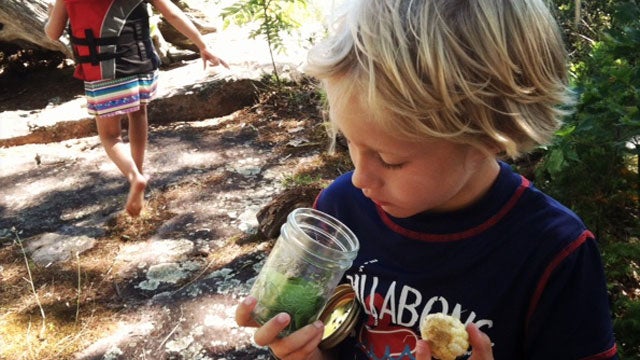Yesterday afternoon, during a mad dash to hustle my two daughters out the door to soccer practice—so I could write this post in peace and quiet—I screamed so much and so loudly that half an hour after they left, I was still hoarse. I slunk guiltily around the silent house feeling wretched, taking small consolation in that it’s fall and our windows are shut so the neighbors couldn’t hear me hollering at the girls to put on their cleats.

These days it seems hurrying has become our default pace. We rush to get to school, we blast to finish deadlines, we scurry to meetings, and we book it home for dinner. And then—let’s go!— we hustle to get the kids to bed so they’re not zombies when the race starts all over again the next day.
I knew we had a problem when I picked up Pippa from her first day of kindergarten. I asked her how she liked school. “My teacher’s always in a rush,” she told me matter-of-factly. I was impressed by her sharp observation, but also a little freaked. Children are sponges: They mimic our actions and words, and the way we move through the world, which, increasingly, is all too hastily. If she’s getting the rush job at home and at school, how will she ever learn how sweet it feels to take her time?
For the past year, I’ve been experimenting with ways to slow down family life while still playing hard and staying active. We’ve tried to reduce our screen time, leave entire weekends unscheduled, and sleep outside in nature every month. Some of our strategies have worked, while others haven’t (so much for turning off my computer every night by 9 p.m.—it’s 10:30 as I type this).
More than anything, I’ve learned to stop resisting our busy life and accept that our family will always be the kind that craves adventure, crams our schedule with trips and schemes, and says yes before we say no. This isn’t necessarily a bad thing. It just means that when we are home, we need to make a conscious effort to make smarter choices and ruthlessly edit our commitments and to-dos so we don’t run ourselves ragged.
“Slow is not about doing nothing all the time,” writes Bernadette Noll in her new book, . “Rather slow is in the connections made and the mindfulness of the process.”
We might not be able to stop time or even slow it, but if we pay closer attention, we can stretch it and steal it and maybe even be at peace with it. Here are five smart ideas for reclaiming your sanity at home, so that you can enjoy your downtime and your playtime.
FIND A BALANCE
Last week, The New York Times columnist , author of The Secrets of Happy Families, offered a to the argument that today’s children are too overscheduled. Too much free time can be just as taxing, he says. “When we do leave our kids on their own for long stretches, they end up wrestling on the floor, finding their way into a fight, or demanding screen time.”
Most organized activities involve a certain amount of pressure to get there and back on time, which adds stress to the weekly routine. Rather than just muddle on, Noll suggests looking at each of your family’s commitments—from team sports to travel to music lessons—and ask yourself: “Is it working for us?” Do the benefits outweigh the hassles? Does the fun trump the frustration? If the answer is yes, keep doing it. If not, nix from the roster.
IT’S OK TO ASK FOR HELP
I love watching Pippa tear around on sprawling soccer fields; the green grass—a novelty in the Southwest—makes up for the logistical headaches of getting to and from practice. But yesterday’s tantrum taught me that on soccer days, we need to make a few simple tweaks to the schedule. We’ve figured out that if Steve comes home 15 minutes early to help wrangle little legs into shin guards, and the girls play with Pete in the yard while I make quesadillas for their “road picnic” dinner, the transition from school day to sports practice goes more smoothly for all of us.
MAKE IT A FAMILY AFFAIR
If you decide that organized sports are more stress than they’re worth, you don’t have to give up the activity all together. In Slow Family Living, Noll recounts how her family’s schedule went haywire when three of her four children started playing in the local soccer league. Trying to coordinate five nights of practice, plus games on the weekends, was making them crazy. So they bowed out and teamed up with family friends for a weekly game of co-ed, multigenerational family soccer. “After just one game, the kids were hooked,” Noll writes. “They loved that they all got to play on the same team. They loved that the parents played with them, rather than standing on the sidelines shouting out instructions.”
There are plenty of other ways for the whole gang to get in the game, too. One mother signed her family up for a karate class for all ages. Another asked her daughter, who was a competitive swimmer, to become the resident swim coach and design workouts for the rest of the family.
RIDE YOUR BIKE
Freewheeling around town on two wheels is the fastest way to slow down. Whenever I’m feeling stressed and sick of playing taxi, I ditch the car and load the girls on our cargo bike. Suddenly, routine errand-running and school drop-offs become spontaneous adventures, and we always arrive at our destination happier and calmer than when we left.
Maybe this explains why, according to UNICEF’s recent study, Dutch kids are the happiest children in the developed world (American youth rank 26 out of the 29 nations studied). In the city of Groningen, in particular, bicycles outnumber cars by more than three to one, and a quarter of all commuting trips are done by bike. The Dutch have created a two-wheel utopia that helps children and their families thrive.
EMBRACE INFORMAL GET-TOGETHERS
Growing up with my siblings in suburban New Jersey, one of the highlights of our year was the Fernwood Road block party. All the families on the street gathered for a roving barbecue, with impromptu backyard whiffle ball games and hopscotch drawn in chalk right on the road. The kids ran free until long after dark, while our parents milled around drinking gin and tonics. Looking back, it all seems so quaint, but just because we live much busier and more insular lives doesn’t mean we have to squash the impulse to gather outside with neighbors and friends.
The modern equivalent, suggests Noll, is multi-family park night. Call some friends, clean out the fridge, and meet for dinner a local park. Bring bikes, balls, scooters, and beer, or head to a local trailhead for a picnic and hiking.
A few weeks ago, some friends hosted their annual fall mountain brunch at the local ski area. A dozen families hiked half a mile up the grassy ski run, carrying babies and blueberry muffins, plates of bacon and whatever else was handy in the house. The kids made birdseed art and hunted for bugs, while the adults drank coffee from thermoses and caught up with each other. It was nothing forced or fancy, just a chance to come together with our tribe.


